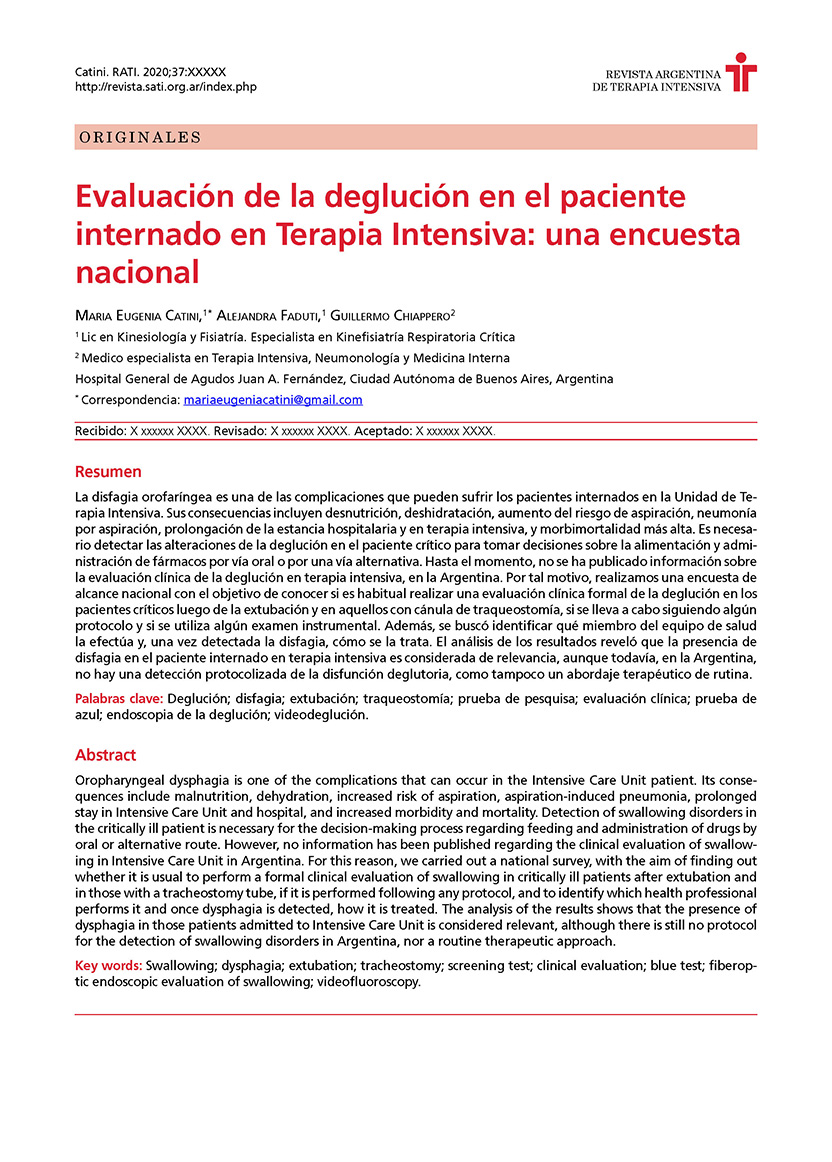Swallowing evaluation in patients admitted to Intensive Care: a national survey
Main Article Content
Abstract
Oropharyngeal dysphagia is one of the complications that can occur in the Intensive Care Unit patient. Its consequences include malnutrition, dehydration, increased risk of aspiration, aspiration-induced pneumonia, prolonged stay in Intensive Care Unit and hospital, and increased morbidity and mortality. Detection of swallowing disorders in the critically ill patient is necessary for the decision-making process regarding feeding and administration of drugs by oral or alternative route. However, no information has been published regarding the clinical evaluation of swallowing in Intensive Care Unit in Argentina. For this reason, we carried out a national survey, with the aim of finding out whether it is usual to perform a formal clinical evaluation of swallowing in critically ill patients after extubation and in those with a tracheostomy tube, if it is performed following any protocol, and to identify which health professional performs it and once dysphagia is detected, how it is treated. The analysis of the results shows that the presence of dysphagia in those patients admitted to Intensive Care Unit is considered relevant, although there is still no protocol for the detection of swallowing disorders in Argentina, nor a routine therapeutic approach.
Article Details
The magazine does not retain the reproduction rights (copyright) so the authors can republish their works with the sole mention of the original publication source.
References
2. Snippenburg W, Kroner A, Flim M, Hofhuis J, Buise M, Hemler R, Spronk P. Awareness and Management of Dysphagia in Dutch Intensive Care Units: A Nationwide Survey. Dysphagia. 2019;34(2):220-228.
3. Omura K, Komine A, Yanagigawa M, Chiba N, Osada M. Frequency and outcome of post-extubation dysphagia using nurse-performed swallowing screening protocol. Nurs Crit Care. 2019;24 (2):70-75.
4. Pryor L, Ward E, Cornwell P, O’Connor S, Chapman M. Patterns of return to oral intake and decannulation post-tracheostomy across clinical populations in an acute inpatient setting. Int J Lang Commun Disord. 2016; 51 (5): 556-67.
5. Goldsmith T. Evaluation and treatment of swallowing disorders following endotracheal intubation and tracheostomy. Int Anesthesiol Clin 2000;38(3):219-42.
6. Moraes DP, Sassi FC, Mangilli LD, Zilberstein B, de Andrade CR. Clinical prognostic indicators of dysphagia following prolonged orotracheal intubation in ICU patients. Critical Care 2013; 17(5):R243.
7. Skoretz SA1, Flowers HL, Martino R. The incidence of dysphagia following endotracheal intubation: a systematic review. Chest 2010;137(3):665-73.
8. Pauliny M, Christova E, Mackova J, Liska M. Percutaneous dilation tracheostomy versus surgical tracheostomy in critically ill patients. Bratisl Lek Listy. 2012; 113 (7): 409-11.
9. Mehtay C, Mehta Y. Percutaneous Tracheostomy. Ann Card Anaesth. 2017; 20 (Supl. 1):S19 – S25.
10. Raimondi N, Vial MR, Calleja J y col. Guías basadas en la evidencia para el uso de traqueostomía en el paciente crítico. Med Intensiva. 2017;41(2):94-115.
11. Khammas A, Dawood MR. Timing of Tracheostomy in Intensive Care Unit Patients. Int Arch Otorhinolaryngol. 2018; 22(4): 437–442.
12. Garuti G, Reverberi C, Briganti A, Massobrio M, Lombardi M, Lusuardi M. Swallowing disorders in tracheostomised patients: a multidisciplinary/multiprofessional approach in decannulation protocols. Multidisciplinary Respiratory Medicine 2014; 9(1):36.
13. Sharma OP, Oswanski MF, Singer D, Buckley B, Courtright B, Raj SS, Waite PJ, Tatchell T, Gandaio A. Swallowing disorders in trauma patients: impact of tracheostomy. Am Surg 2007; 73:1117–1121.
14. Macht M, Wimbish T,. Clark BJ, Benson B, Burnham L, Williams A, Moss M. Diagnosis and treatment of post-extubation dysphagia: Results from a National Survey. J Crit Care. 2012; 27(6): 578–586.
15. Hafner G, Neuhuber A, Hirtenfelder S, Schmedler B, Eckel H. Fiberoptic endoscopic evaluation of swallowing in intensive care unit patients. Eur Arch Otorhinolaryngol. 2008; 265(4): 441–446.
16. Suiter DM, Sloggy J, Leder SB. Validation of the Yale Swallow Protocol: A Prospective Double-Blinded Videofluoroscopic Study. Dysphagia 2014; 29 (2):199–203.
17. Linhares Filho TA, Arcanjo FPN, Zanin LH, Portela HA, Braga JM, da Luz Pereira V. The accuracy of the modified Evan’s blue dye test in detecting aspiration in tracheostomised patients. J Laryngol Otol 2019;133(4):1–4.
18. Fredes S, Tiribelli N, Setten M, Rodrigues La Moglie R, Plotnikow G, Busico M y cols. Definición del rol y las competencias del kinesiólogo en la Unidad de Cuidados Intensivos. Revista Argentina de Terapia Intensiva, 2018; 35(4).
19. Rodrigues Padovani A, Furquim de Andrade C. Functional profile of swallowing in clinical intensive care. Einstein. 2007; 5(4):358-362.
20. Vera-González R. Disfagia Post Extubación en Pacientes Críticos. Rev Chilena de Medicina Intensiva 2019; 34 (3):1-8.
21. Singh R, Saran S, Baronia A. The practice of tracheostomy decannulation—a systematic review. J Intensive Care. 2017; 5: 38.
22. Villalba D, Lebus J, Quijano A, Bezzi M, Plotnikow G. Retirada de la cánula de traqueostomía. Revisión bibliográfica. Revista Argentina de Terapia Intensiva. 2018; 31(1).
23. Marvin S, Thibeault S, Ehlenbach J. Post-extubation Dysphagia: Does Timing of Evaluation Matter? Dysphagia. 2018;34(2):210-219.
24. Rodrigues Padovani A, Pedroni Moraes D, Chiarion Sassi F, Furquim de Andrade C. Clinical swallowing assessment in intensive care unit. CoDAS 2013;25(1):1-7.
25. Donzelli J; Brady S, Wesling M, Craney M. Simultaneous Modified Evans Blue Dye Procedure and Video Nasal Endoscopic Evaluation of the Swallow. Laryngoscope. 2001; 111:1746–1750.
26. Be´chet S, Hill F, Gilheaney O, Walsh M. Diagnostic Accuracy of the Modified Evan’s Blue Dye Test in Detecting Aspiration in Patients with Tracheostomy: A Systematic Review of the Evidence. Dysphagia. 2016; 31(6):721-729
27. Christensen M, Trapl M. Development of a modified swallowing screening tool to manage post-extubation dysphagia. Nurs Crit Care. 2018;23(2):102-107.
28. Aviv E, Kim T, Thomson JE, Sunshine S, Kaplan S, Close LG. Fiberoptic Endoscopic Evaluation of Swallowing with Sensory Testing (FEESST) in Healthy Controls, Dysphagia. 1998; 13:87–92
29. Hiss S, Postma GN, Fiberoptic Endoscopic Evaluation of Swallowing. Laryngoscope. 2003; 113:1386–1393.
30. Santana L, Fernandes A, Brasileiro A, Abreu A. Criteria for clinical speech therapy Evaluation of tracheostomized patient in hospital bed and home care. Rev. CEFAC. 2014; 16(2):524-535.
31. Hess D, Altobelli N. Tracheostomy Tubes. Respiratory Care. 2014; 59(6): 956-973

